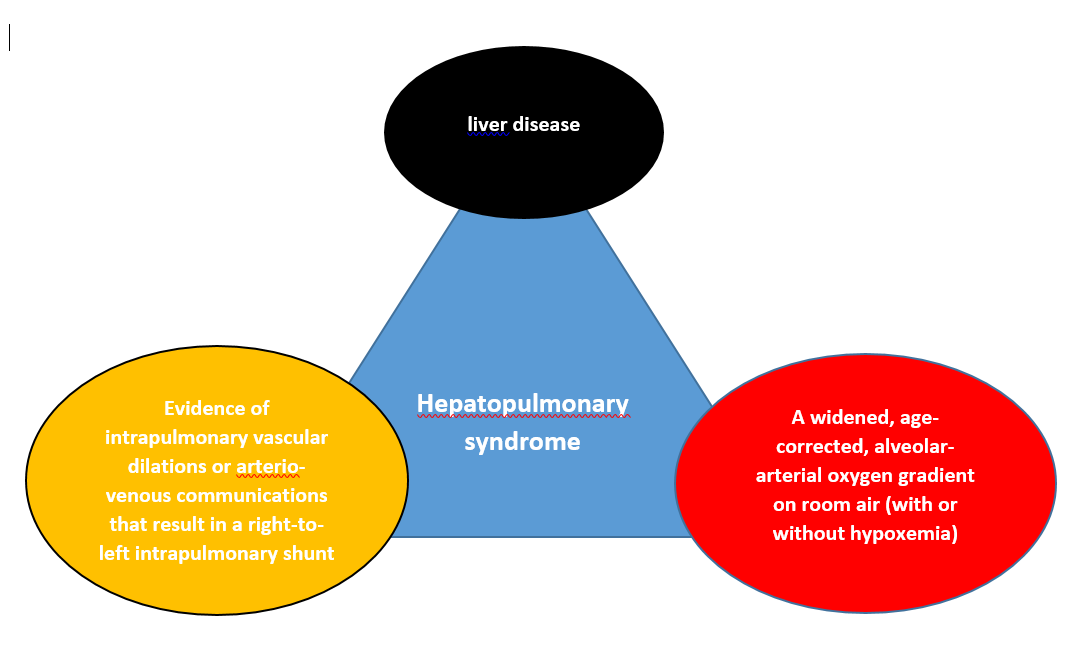Hepatopulmonary syndrome diagnostic study of choice: Difference between revisions
| Line 12: | Line 12: | ||
Study of choice | |||
There is no single diagnostic study of choice for the diagnosis of hepatopulmonary syndrome, but hepatopulmonary syndrome can be diagnosed based on history of '''liver disease''', atrial blood gas analysis (widened '''alveolar-arterial oxygen gradient''' measurement); and evidences of '''intra-pulmonary vascular dilation''' or arterio-venous communications that result in a '''right-to-left intrapulmonary shunt.''' | |||
'''Investigations:''' | |||
* Among the patients who present with clinical signs of hepatopulmonary syndrome, the [[Hepatopulmonary syndrome echocardiography and ultrasound|'''contrast-enhanced transthoracic echocardiography with agitated saline''']] is the most specific test for the diagnosis. | |||
* Among the patients who present with clinical signs of hepatopulmonary syndrome, the [[Hepatopulmonary syndrome laboratory findings|'''atrial blood gas analysis''']] is the most sensitive test for diagnosis. | |||
<br /> | |||
=== | ===== Diagnostic results ===== | ||
The following findings are confirmatory for hepatopulmonary syndrome: (discussed in details) | |||
* Presence of bubbles on the left heart in contrast-enhanced transthoracic echocardiography with agitated saline | |||
* Presence of radioactivity on the left heart in Technetium 99m-labeled macroaggregated albumin scanning | |||
*Diffusion defect in atrial blood gas analysis particularly studying | |||
*Abnormal liver function studies | |||
*Abnormal pulmonary function test | |||
* | |||
* | |||
* | |||
<br /> | |||
==References== | ==References== | ||
Revision as of 16:24, 31 July 2019

|
Hepatopulmonary syndrome Microchapters |
|
Differentiating Hepatopulmonary syndrome from other Diseases |
|---|
|
Diagnosis |
|
Treatment |
|
Case Studies |
|
Hepatopulmonary syndrome diagnostic study of choice On the Web |
|
American Roentgen Ray Society Images of Hepatopulmonary syndrome diagnostic study of choice |
|
Hepatopulmonary syndrome diagnostic study of choice in the news |
|
Blogs on Hepatopulmonary syndrome diagnostic study of choice |
|
Risk calculators and risk factors for Hepatopulmonary syndrome diagnostic study of choice |
Editor-In-Chief: C. Michael Gibson, M.S., M.D. [1]; Associate Editor(s)-in-Chief: Soroush Seifirad, M.D.[2]
Overview
There is no single diagnostic study of choice for the diagnosis of hepatopulmonary syndrome, but hepatopulmonary syndrome can be diagnosed based on history of liver disease, atrial blood gas analysis (widened alveolar-arterial oxygen gradient measurement); and evidences of intra-pulmonary vascular dilation or arterio-venous communications that result in a right-to-left intrapulmonary shunt.
Diagnostic Study of Choice
Study of choice
There is no single diagnostic study of choice for the diagnosis of hepatopulmonary syndrome, but hepatopulmonary syndrome can be diagnosed based on history of liver disease, atrial blood gas analysis (widened alveolar-arterial oxygen gradient measurement); and evidences of intra-pulmonary vascular dilation or arterio-venous communications that result in a right-to-left intrapulmonary shunt.
Investigations:
- Among the patients who present with clinical signs of hepatopulmonary syndrome, the contrast-enhanced transthoracic echocardiography with agitated saline is the most specific test for the diagnosis.
- Among the patients who present with clinical signs of hepatopulmonary syndrome, the atrial blood gas analysis is the most sensitive test for diagnosis.
Diagnostic results
The following findings are confirmatory for hepatopulmonary syndrome: (discussed in details)
- Presence of bubbles on the left heart in contrast-enhanced transthoracic echocardiography with agitated saline
- Presence of radioactivity on the left heart in Technetium 99m-labeled macroaggregated albumin scanning
- Diffusion defect in atrial blood gas analysis particularly studying
- Abnormal liver function studies
- Abnormal pulmonary function test